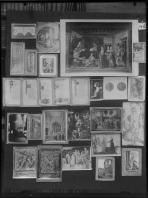Carrying has structurally to do with dynamis and kinesis: it is a specific kind of corporeal movement and a spatial translation of a physical object. This is perhaps why Warburg introduces in the panel a female figure who does not actually carry anything, but is simply moving: #7 (a drawing by Giuliano da Sangallo representing a mobile woman), implying that from a logical and categorial point of view (Umfang or extension of classes) the action of carrying something is a sub-class of bodily movement in general.
The rendering of a mobile body constituted a major challenge in visual pre-cinematographic arts and was one that emerged as a central issue in Warburg’s earliest scholarly reflections; namely, how to represent movement in static pictures (one could say: how to make cinema before cinema). Warburg was intrigued by the psychophysiological doctrines of objectual Einfühlung (empathy: interacting with an object as if it were a subject) in order to find a possible solution to such a challenge: already in his 1893 Botticelli dissertation – see panel 39 of the Atlas for an iconic articulation of this issue – we find explicit reference to Robert Vischer’s essay On the Optical Sense of Form (1873), in which perception is connected to motor functions and to the process of “animation of the dead phenomenon, a rhythmic enlivening and revitalization of it.”
Another relevant source concerning this issue was The Problem of Form (1893) by Adolf von Hildebrand. There, in chapter 6 (devoted to form as functional expression, vivified by the beholder’s bodily feelings), the German sculptor and theorist outlines a doctrine of formal and bodily types very close to Warburg’s own approach.
Last but not least, a 1856 lecture by the architect and theorist Gottfried Semper devoted to the laws of adornment as an artistic symbol introduced Warburg to the fascinating domain of mobile decorations – in particular the so-called Richtungsschmuck (directional ornament) – and accessories: hairdo, veils, and draperies all acting as bodily prosthesis capable of integrating and implementing the dynamic effects of the image.
If we mix together the three ingredients (woman, movement, mobile accessories) we obtain as a highly unstable result the figure of the Nymph, one of the most emblematic and enigmatic characters of panel 46, of the Atlas as a whole, and of the entire parabola of Warburg’s intellectual life: a figure that will be – dulcis in fundo – the focus of our last sequence.
